0 Introduction
The liberalization of the energy market has promoted the decentralization of electric energy sources.Global warming has resulted in extreme weather events,which have caused considerable loss of life and property.Therefore,reducing CO2 emissions is critical.In Japan,the use of renewable energy (RE) has increased rapidly,and the installed photovoltaic (PV) panels have shown a significant production capacity of 63 GW in 2020 [1].However,to achieve the “Carbon Neutral 2050” target proposed by the Japanese Government,drastic reforms are necessary in both technology and policies.Therefore,RE sources are investigated to achieve this goal.The replacement of fossil power plants with RE sources is being considered to render RE as the major energy source.Battery energy storage systems (BESSs) are critical for mitigating RE fluctuations and maintaining power system stability.Therefore,among energy storage systems,BESSs are the best choice from economic and environmental perspectives [2].
The estimation of BESS capacity is crucial for effective power management.The optimal battery capacity can be calculated by considering the load pattern of users,RE source,and grid power cost.The objective function is to minimize cost or maximize financial benefit [3].However,the required battery capacity should be estimated based on the policies of each country.Therefore,BESS capacity sizes are being investigated globally based on the requirements of each country [4].Battery manufacturing and investment for R&D of BESSs have been bolstered by the prediction of an emerging market.
The biggest obstacle to the use of storage batteries is their price,which remains high despite considerable efforts.However,multipurpose use of stored energy can enable cost reduction.If a set of BESSs can be shared by multiple users and used for various purposes,the cost of the BESS can be reduced.Thus,the operation of BESSs is a key technology in smart grids that is considered by the balancing group.The operational efficacy depends not only on engineering problems,such as the physical characteristics of the cell and control of charge/discharge patterns but also on political/legal regulations,market mechanisms/rules,and grid code of the power system [5].
Cost reduction of batteries will be primarily achieved by the extensive research efforts toward manufacturing techniques.Conversely,the cost of the BESS can be relatively reduced when it is used by many users [6].Various new businesses have been developed,and the advanced Internet of things has enabled the balancing group to control microgrids.The multipurpose use of batteries is a new key factor in the coming era [7][8].
Vehicle-to-grid and vehicle-to-home technologies,which connect the mobile battery of an electrical vehicle(EV) to power systems and homes,respectively,are becoming increasing crucial [9].The storage batteries of the latest private EVs have the capacity to supply the electricity demand of general households for a week.This implies that the distributed battery storage system of an EV can be the dominant battery and replace the batteries installed in substations [10].Old EV batteries can also be repurposed for secondary use.This reuse of in-vehicle storage batteries can provide certain economic benefits to EV users and accelerate the penetration of BESS into society [11][12].
Safety and reliability are essential parameters in BESS operation.Battery failure or malfunction can cause catastrophic explosions or fire.Therefore,cell manufacturers are attempting to achieve high safety and minimize cost by using safe and easily available materials.In system integrators,measuring systems are used to detect abnormalities early and cut off the current or extinguish fire before a fire spreads or explosion occurs to ensure safety.
The other issue is the loss of inertia.A shift in the energy source from conventional rotary generators to inverter-based RE sources results in the loss of “inertia” in the power system [13].The inertia of the rotary generator at the power plant is the most dominant factor in maintaining the transient stability of the power grid.Therefore,stability under the gradual loss of inertia is a critical topic of research[14].In addition to the transient/dynamic stability and supply-load balance problems related to the entire power grid,considering the voltage problem related to the local distributed network is crucial.
In this paper,various usages of BESS are classified and the practical applications are surveyed in Chapter 2.In Chapter 3,an analysis of certain combinations of applications for multipurpose use of BESSs and their operation without conflict are discussed.An approximate estimation of the required total storage capacity of BESSs in Japan is presented.This result warns that a greater BESS capacity is required to support the promotion of RE than former estimations.In Chapter 4,the recent trends in the various applications of BESS are discussed.
1 Multipurpose Application of Battery Energy Storage System (BESS)
Carbon neutrality cannot be achieved if fossil-fuel-fired thermal generators are used.Pumped-storage hydro power plants are superior energy storage devices,and suitable sites have been developed in countries such as Japan.However,new developments cannot be undertaken without the destruction of natural resources.Therefore,BESSs are the most feasible option and are indispensable to making RE the major energy source in power systems.Because BESSs can be used for various purposes,they can be shared by multiple users [15][16].In this section,recent usages of BESS are discussed.
1.1 Load leveling
One of the most conventional applications of the BESS is “load leveling.” Load leveling is performed by charging the storage battery at night using inexpensive nuclear power plants and discharging the storage battery during the daytime instead of generating power using expensive thermal power plants.Therefore,the construction of polluting thermal power plants with a high generation cost can be avoided.Another advantage is that CO2 emissions can be reduced by replacing fossil power plants by nuclear power plants.Demand-side consumers can select a discounted contract or suppressed tariff by improving their load factor.Although the situation has changed significantly with the advent of RE,load leveling still provides benefits to both supply and demand sides.
A similar function can be achieved by using pumpedstorage hydropower plants.However,BESSs exhibit another advantage as they are installed near the demand side.This geographical benefit reduces overload of transmission/distribution network cables and postpones the expansion/construction of new cables.BESSs located near the demand side exhibit reduced transmission loss within the entire power system.This phenomenon contributes to social benefits,such as CO2 reduction.
1.2 Ancillary service
Today,countries are analyzing methods that provide financial incentives for efforts that contribute to power system operations [17].In the market,“reserve,” “capacity,”“negawatt/posiwatt,” and other ancillary services are procured by the power grid operator.Market rules have already been formulated in advanced countries,and such ancillary services are bought and sold in the power market.A purpose of opening the capacity market was to avoid the abolition of unprofitable thermal power plants and reserve the controllability of supply and demand balance [18].However,the current global public opinion does not accept thermal power plants.BESS will be the only way to support ancillary services in the market.
1.3 Mitigation of fluctuations in RE output
BESSs can absorb fluctuations caused by RE sources.Short-term operation within a timeframe of seconds can be covered by the frequent charge and discharge operation of BESSs,as the response speed is significantly high [19].Therefore,power capacity (kW) is considered in BESSs rather than energy capacity (kWh).The required power capacity depends on the nature of the RE.The RE output can suddenly change by more than 50% within minutes; thus,the power system operator or specified grid code may require BESSs with abundant power/energy capacity [20].
1.4 Energy shift to night and absorption of surplus photovoltaic energy
Owing to the penetration of PV energy by feed-in tariff(FIT) policies,more PV energy is being used to power the grid during the day.As PV power increases,fossil thermal power generators can be suppressed to reduce power generation costs and CO2 emissions.However,if too much PV power is imposed,thermal plants have no room for control.To accept a larger amount of RE,a storage battery that can absorb excess PV energy in the daytime and discharge it at night is indispensable.Thus,this energy shift is significantly important.
1.5 Emergency power supply
The reliability of power systems in developed countries is high.For example,blackouts seldom occur in Japan.However,high-intensity natural disasters disrupt power supply and cause severe and large-scale damage.Power disruption challenges during these natural disasters can be overcome by preparing emergency power supply infrastructure.BESSs were not used as emergency power supply systems in the past as they are completely useless after discharging all the energy.The installation of RE sources and BESSs in an area will be a robust emergency source of power.This combination is more reliable than conventional diesel generators using oil tanks,where the destruction of roads and distribution networks can severely damage the supply chain.In certain cases,bad weather may reduce daylight hours.However,such bad weather conditions rarely persist for several days.
1.6 Preventing voltage sag
Voltage sag indicates an instant voltage decline,which causes considerable economic damages to manufacturers involved in the semiconductor industry and precision machinery [21].Because this event is caused by the normal operation of circuit breakers,avoiding such events from the supply side is difficult.Therefore,such manufacturers should equip a countermeasure against voltage sag.BESS can be a key element in such countermeasure systems.This function is similar to an uninterrupted power supply system.However,faster switching speeds are required for protection from voltage sags.
1.7 Improvement of power quality
In factories with electric furnaces and rolling processes,intermittent loads can cause harmonics and three-phase imbalances in voltages and currents.Because a single-phase power conditioner (inverter) is used in rooftop PV systems that are installed in houses,it causes a phase imbalance in the three-phase system.Static VAR compensator and/or static synchronous compensator (STATCOM) are used to improve the power quality.STATCOM requires a DC voltage source.BESSs are used as an essential voltage source (or energy source) along with STATCOM.
1.8 Role in power market
With the increase in the proportion of RE in the power grid,the reduced controllability of power balance has become a critical concern.To compensate for this problem,capacity and reserve markets were developed [22].These markets were initially aimed at protecting fossil fuel power plants.However,this protection is not consistent with public opinion.Consequently,BESS will become the major supplier for the capacity market.
Arbitrage is the business of profiteering by charging energy when the price is low and discharging energy when the price is high in the electricity market [23].Because the cost of BESSs is high,this business has remained unprofitable.However,with the cost reduction of BESSs owing to their smart multipurpose usage,the arbitrage business has become promising.In Japan,the FIT system has prohibited the combined use of the BESS and PV system; however,this combination will be accepted in the new feed-in premium system that is under consideration.
1.9 Practical multipurpose utilization of storage batteries
The multipurpose use of BESS is not a new concept.NaS (Na and S with beta alumina solid electrolyte)battery is widely used in Japan for various purposes.The commercial installation of NaS batteries in 99 sites by the Tokyo Electric Power Company in the Tokyo area in 2010 produced 185 MW (demand-side users=96,substations=3).A fire accident occurred at a demand site in September 2011.Until the survey and countermeasure were completed,all systems were stopped.After 2013,the operation was restarted.The multipurpose use of demand-side users is summarized in Table 1.
Table 1 Multipurpose Use of NaS Battery by Demand-Side Users
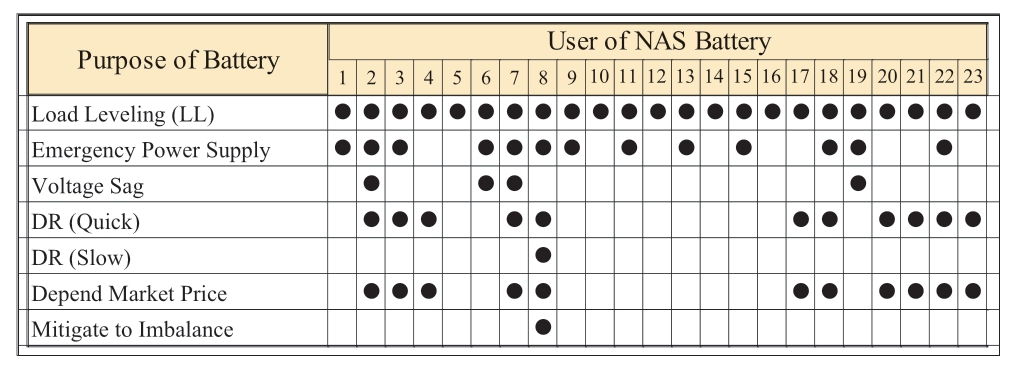
2 Combination of Different Applications of BESS
2.1 Load leveling and smoothing
Among the multiple applications of BESSs,traditional load leveling can be effectively combined with smoothing of PV fluctuations.If two batteries are installed in two sites and they are operated individually,the batteries exhibit satisfactory performance in each site.However,the total cost of operation will be high.If the BESS is simultaneously used for both load leveling and smoothing of the PV fluctuations,better load management is achieved from the perspective of the “grid operator.” The total cost is also suppressed,because one battery is installed for two purposes.A schematic of this application is illustrated in Fig.1.
Although it is technically possible to share power storage equipment as shown in Fig.1,such a business form was not permitted in Japan till now.However,in the future,it will be possible to own “Battery Stations” that are not classified as power plants or consumers.
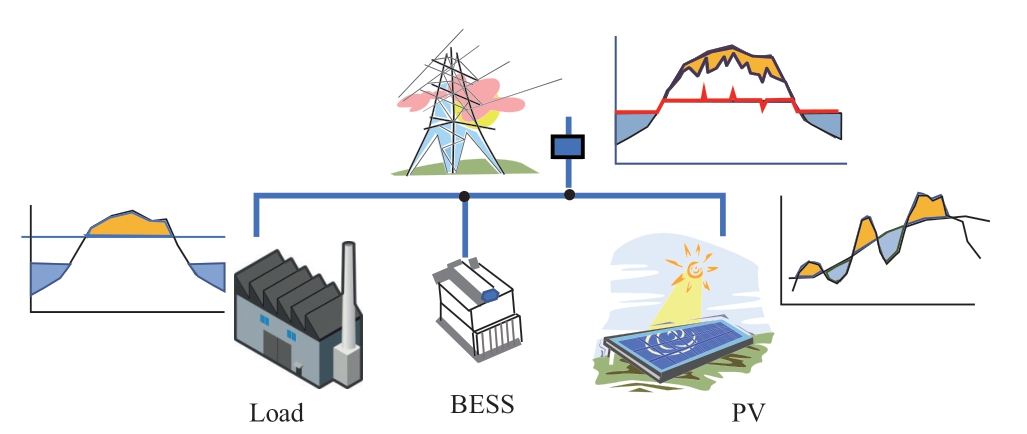
Fig.1 Multipurpose Use of Batteries for Load Leveling and Smoothing of Photovoltaic Fluctuations
Because a battery is used simultaneously for two or more purposes,conflicts may occur.However,this combination of load leveling and smoothing operations can share the capacity without severe conflicts.Fig.2 illustrates the mechanism why this combination prevents conflicts.Owing to recent actions performed for demand-side management,the shape of the load curve tends to be flat.Under this condition,the output of the BESS in kilowatts is small and the duration of discharge is long.Therefore,there is sufficient surplus kilowatt capacity that can be used for smoothing the PV outputs.The output of the PV system also helps to reduce peak load during the day in sunny weather,when the air-conditioning load is high.The PV system itself implements the function of load leveling.
The charge/discharge pattern shown in Fig.2 is changing significantly owing to the widespread use of RE sources,especially PV energy.Fig.3 shows the recent charge/discharge patterns.Even if the load leveling pattern changes in this way,storage batteries can be similarly used for multipurpose applications.
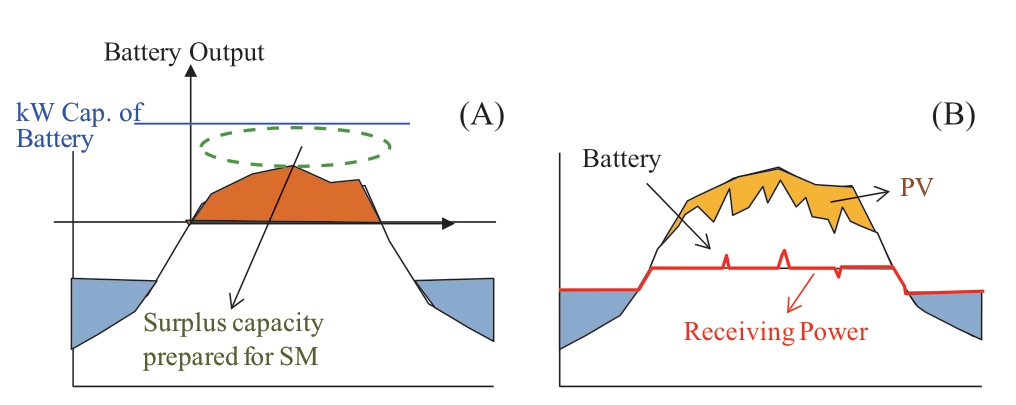
Fig.2 Multipurpose Use Without Conflicts
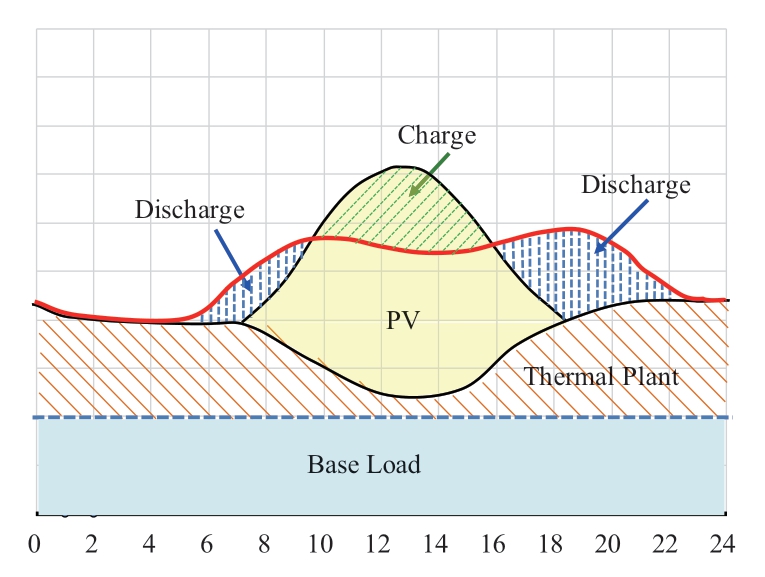
Fig.3 Recent Charge/Discharge Patten
The total charging capacity of a pumped-storage hydro power plant is 13 GWh in Japan.Moreover,the rated capacity is 27.6 GW (45 sites).This capacity is insufficient for managing the expected PV output in the future.Moreover,there are no suitable remaining sites where new pumped-storage hydro plants can be built in Japan.Therefore,it is obvious that more batteries will be required as available energy storage systems.The author personally estimated that 150–200 GWh capacity will be needed by 2030 in Japan.
2.2 Emergency power supply and load leveling
Recent natural disasters have often damaged the social infrastructure such as electric power and traffic systems.In the current modern society,these damages have only caused greater disruptions.Consequently,business continuity planning is crucial for the functioning of most organizations under such scenarios.In Japan,a prolonged power outage was caused by a typhoon in Chiba Prefecture in 2019,and power was completely restored only after 19 days.
According to the domestic laws,an emergency power supply system is mandatory for large buildings in Japan.Diesel generators are used in many cases; however,the operation duration is short with a maximum duration of approximately one day.The operation duration can be extended by adding more fuel tanks; however,this is not recommended from the perspective of safety management.
Because the output of the PV system depends on weather conditions,PV is generally considered to be unsuitable as an emergency power source.However,a combination of a PV system with BESS as an emergency power supply can achieve improved reliability.This system is ineffective if rainy days continue for several days after an outage.However,the probability of bad weather continuing after a natural disaster is less than the probability of damage to transportation and power grids.
A schematic of the multipurpose use of a battery for emergency power supply and load leveling is illustrated in Fig.4.The operation of this combined system is performed as follows:

Fig.4 Schematic Image of a Battery as an Emergency Power Supply
(1) During a normal operation,the output of the BESS is controlled by Valve-R,where surplus energy from the PV system is charged during the day and discharged in the evening.At this time,some portion of the energy (e.g.,10%) is retained unused in the battery.This energy is retained for emergency purposes.
(2) If the state of charge of the BESS exceeds 100%,the surplus energy flows to satisfy the energy demands.If allowed,the surplus may be sent to the grid.
(3) In case of a power outage,Valve-E is opened to use the energy that is stored for emergency use.
Because 10% of the energy is unused for regular load leveling,the performance of this system is marginally less.However,this effect is almost negligible.
When using diesel power as an emergency power source,startup (booting) may fail.This is because the event of startup is performed rarely through the operational years.If BESSs are used daily for nonemergency purposes,the startup of emergency power supply will be more reliable,because we can detect detrimental conditions in advance.
3 Recent Applications of BESS in Japan
Large-scale storage batteries have been introduced in Japan owing to the widespread use of RE.In the past,several model projects were subsidized by the Ministry of Economy,Trade,and Industry (METI); however,recently,they have been used in economically independent projects.Although the cost of a battery is still expensive,power grid operators have started purchasing massive battery systems to manage RE sources.
3.1 Large-scaled lithium-ion battery station in Hokkaido
Hokkaido,which is located in the northern part of Japan,has high-potential wind power generation capacity,and the construction of a large-scale onshore wind power plant is underway.However,as the area that is suitable for wind power generation is located in a depopulated area in the north,there was a concern that the transmission capacity of the transmission line was insufficient.Fig.5 shows the high-potential wind power area and the weak transmission networks in Hokkaido [23].
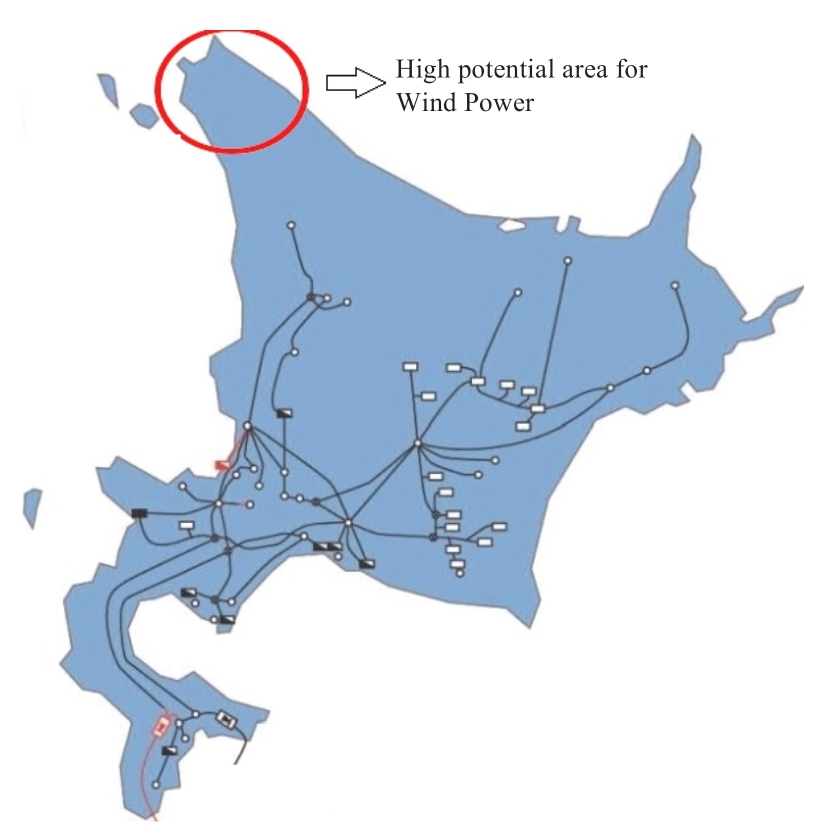
Fig.5 High-potential Wind Generation Area and Grids in Hokkaido
This battery station is planned and possessed by North Hokkaido Wind Energy Transmission Corporation,which is a special purpose company for setting up transmission lines.This system is one of the largest storage battery facilities worldwide with an output of 240 MW and capacity of 720 MWh.The lithium-ion batteries used in these systems were manufactured by a company under GS Yuasa International Ltd.called Lithium Energy Japan.Fig.6 shows an aerial photograph of the lithium-ion battery station set up by GS Yuasa International Ltd.[24].The major features of this battery are listed below:
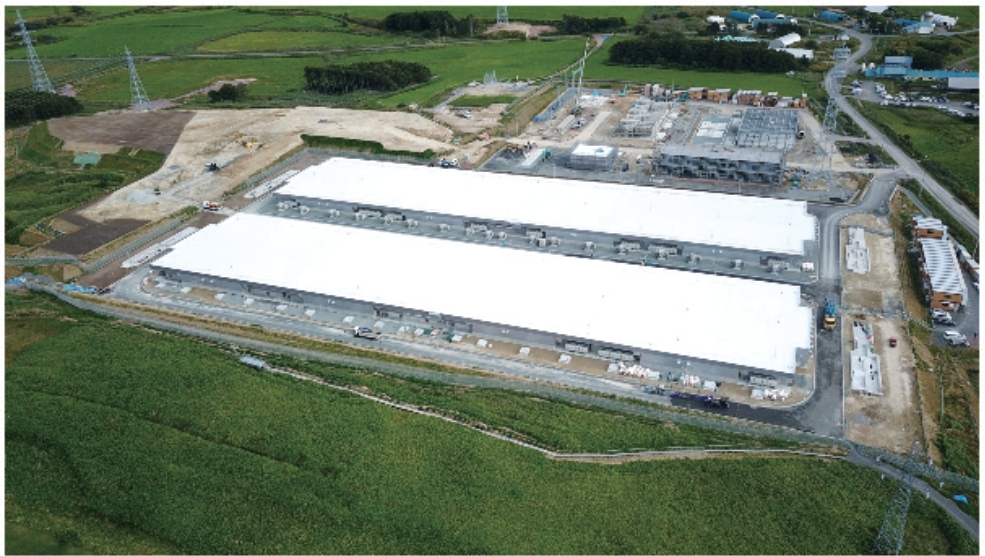
Fig.6 Lithium-ion Battery Station Developed by GS Yuasa International Ltd
(1) Compact cells with longer lifespan are used,
(2) Enables optimum management,
(3) Energy savings in air conditioning by controlling the heat generated at charging and discharging,
(4) Reduction in failure rate and replacement parts,
(5) In compliance with the fire prevention ordinances.
3.2 Large-scale redox flow battery station in Hokkaido
A large 15 MW,60 MWh redox flow battery station was built in 2015 in Hokkaido.This project was financially supported by METI and its proper functioning was demonstrated and confirmed.After five years of operation,Hokkaido Electric Power Network,which is a power grid company,ordered the installation of an additional redox flow battery system in the same substation.The fact that a private company purchased this battery at its own expense without subsidies indicates that this battery has economic rationality.The size of the new battery station is 17 MW,72 MWh.Unlike the first system,the storage battery is being installed directly outdoors to reduce costs.It will be used as a grid-side storage battery for 15 sites producing 162,000 kW of power from wind farms for which interconnections have been accepted.This system will be operated from April 2022.Fig.7 shows an illustration of the battery substation [25].
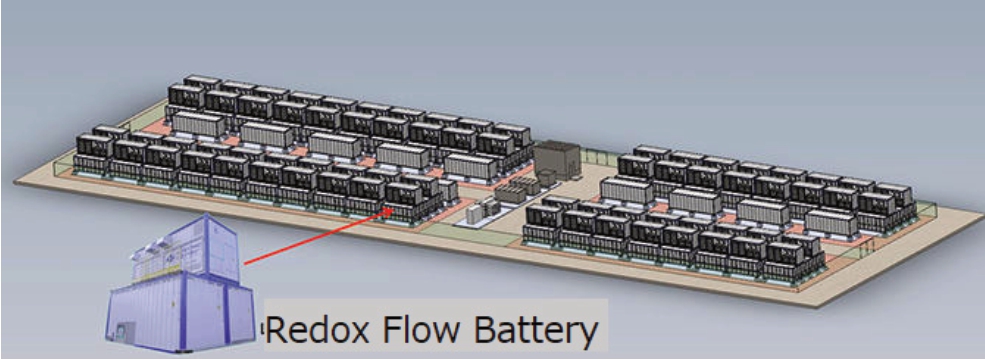
Fig.7 Redox Flow Battery Station Developed by Sumitomo Electric Industries
3.3 Battery station that reuses the old batteries from electric vehicles
Sumitomo Corporation started a new business of reusing EV batteries in Japan.Several businesses based on largescale storage battery systems have been started by reusing/repurposing EV batteries.Because this business model is unique,the Japanese legal system should be updated or renewed considering the relevant policies pertaining to this model.The business plan of these companies is to own independent BESSs that can be connected to power grids,and to lend the storage capacity to multiple users.Until now,the electric power business was divided into two parts,the supply side and consumer/demand side; in contrast,this“battery station” does not belong to either side [10].
It is also remarkable that Sumitomo Corporation reuses the batteries used in Nissan Leaf,which is the most popular full EV in Japan.Moreover,this company has attempted to reduce costs by reusing the battery units of the EVs without disassembling them.
Fig.8 shows a project site owned by Sumitomo Corporation in Koshiki Islands,which is a small island located in the southern part of Kyushu.A battery station of 800 kW/600 kWh composed of 36 reused batteries from Nissan Leaf was constructed beside a 100 kW PV generation unit on the site of an abandoned elementary school.
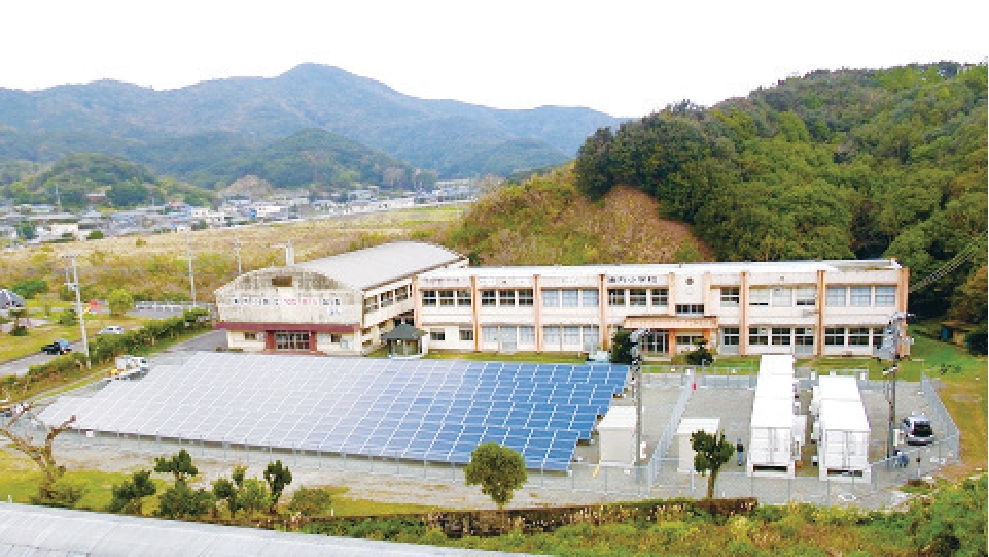
Fig.8 Reused Battery Station Constructed on a Small Island
The capacity of the battery from Nissan Leaf is significantly large (62 kWh) and its safety is guaranteed.Moreover,the cost appears to be reasonable.Currently,there is considerable commercial interest on the success or failure of this business.
4 Conclusion
The multipurpose use of BESSs is essential to reduce the cost of batteries.This paper discussed certain combinations of different applications of BESSs.
In the first part of this paper,various uses of BESSs are described.The possibility of developing multipurpose applications without conflicts was demonstrated.The BESS storage capacity required in 2030 in Japan was derived from the expansion plan of RE and the future demand curve.The future trend of PV energy generation and its demand revealed that approximately 150–200 GWh and 30–40 GW of energy and power capacities,respectively,would be required from BESSs in 2030.
In the second part of this paper,multipurpose applications of BESSs were classified and discussed.BESSs can be used for certain purposes simultaneously without conflicts based on their usage.
In the third part of this paper,recent applications of BESSs in Japan were discussed.NaS and redox flow batteries are advantageous owing to their large energy capacities.A new trend of reusing old batteries was also introduced.
Declaration of Competing Interest
We declare that we have no conflict of interest.
References
[1]T.Haraguchi,K.Iba (2016) Multiple Use of Battery Energy Storage System in Demand Side With Photovoltaic Power Generation,ICEE 2016 Okinawa,Paper ID: 90360
[2]T.Haraguchi,K.Iba (2017) Advanced Operation of Battery Energy Storage System in Demand Side for Multiple Use Including Emergency Source,ICEE2017 Weihai,China
[3]Yang Y,Li H,Aichhorn A,et al.(2014) Sizing strategy of distributed battery storage system with high penetration of photovoltaic for voltage regulation and peak load shaving.IEEE Transactions on Smart Grid,5 (2): 982-991
[4]J.Kong,S.T.Kim,B.O.Kang,et al.(2019) Determining the size of energy storage system to maximize the economic profit for photovoltaic and wind turbine generators in South Korea,Renewable and Sustainable Energy Reviews,116,109467
[5]Bragard M,Soltau N,Thomas S,et al.(2010) The balance of renewable sources and user demands in grids: Power electronics for modular battery energy storage systems.IEEE Transactions on Power Electronics,25 (12): 3049-3056
[6]Paul S,Nath A P,Rather Z H (2020) A multi-objective planning framework for coordinated generation from offshore wind farm and battery energy storage system.IEEE Transactions on Sustainable Energy,11 (4): 2087-2097
[7]Luo F J,Meng K,Dong Z Y,et al.(2015) Coordinated operational planning for wind farm with battery energy storage system.IEEE Transactions on Sustainable Energy,6 (1): 253-262
[8]Moghaddam I N,Chowdhury B,Doostan M (2019) Optimal sizing and operation of battery energy storage systems connected to wind farms participating in electricity markets.IEEE Transactions on Sustainable Energy,10 (3): 1184-1193
[9]Alimisis V,Hatziargyriou N D (2013) Evaluation of a hybrid power plant comprising used EV-batteries to complement wind power.IEEE Transactions on Sustainable Energy,4 (2): 286-293
[10]Web News of Sumitomo Corp.Spread and Expansion of Renewable Energy through Power Storage Business -Reused EV Battery Project on Koshiki Islands.https://www.sumitomocorp.com/en/jp/business/case/group/project_infra01.Accessed 6 May 2022
[11]Zhou C K,Qian K J,Allan M,et al.(2011) Modeling of the cost of EV battery wear due to V2G application in power systems.IEEE Transactions on Energy Conversion,26 (4): 1041-1050
[12]Datta U,Kalam A,Shi J (2019) Battery energy storage system to stabilize transient voltage and frequency and enhance power export capability.IEEE Transactions on Power Systems,34 (3):1845-1857
[13]Gopstein A M (2012) Energy storage & the grid - from characteristics to impact point of view.Proceedings of the IEEE,100 (2): 311-316
[14]Mohandes B,Wahbah M,Moursi M S E,et al.(2021) Renewable energy management system: Optimum design and hourly dispatch.IEEE Transactions on Sustainable Energy,12 (3): 1615-1628
[15]Electric Power Research Institute (2003) EPRI-DOE handbook of energy storage for transmission and distribution applications,Washington,DC,USA.
[16]WECC Modeling and Validation Work Group (2016) WECC battery storage dynamic modeling guideline,Salt Lake City,UT,USA,pp.1-38
[17]Calero F,Cañizares C A,Bhattacharya K (2021) Dynamic modeling of battery energy storage and applications in transmission systems.IEEE Transactions on Smart Grid,12 (1):589-598
[18]Farrokhabadi M,König S,Cañizares C A,et al.(2018) Battery energy storage system models for microgrid stability analysis and dynamic simulation.IEEE Transactions on Power Systems,33(2): 2301-2312
[19]Li X J,Hui D,Lai X K (2013) Battery energy storage station(BESS)-based smoothing control of photovoltaic (PV) and wind power generation fluctuations.IEEE Transactions on Sustainable Energy,4 (2): 464-473
[20]Li X J,Hui D,Lai X K (2013) Battery energy storage station(BESS)-based smoothing control of photovoltaic (PV) and wind power generation fluctuations.IEEE Transactions on Sustainable Energy,4 (2): 464-473
[21]Li M H,Funaki T,Hikihara T (2007) A study of output terminal voltage modeling for redox flow battery based on charge and discharge experiments [C].2007 Power Conversion Conference -Nagoya.Nagoya,Japan.IEEE,221-225
[22]Padmanabhan N,Ahmed M,Bhattacharya K (2020) Battery energy storage systems in energy and reserve markets.IEEE Transactions on Power Systems,35 (1): 215-226
[23]He G N,Chen Q X,Kang C Q,et al.(2016) Optimal bidding strategy of battery storage in power markets considering performance-based regulation and battery cycle life.IEEE Transactions on Smart Grid,7 (5): 2359-2367
[24]News Release of GS Uasa (2018) https://www.gs-yuasa.com/jp/newsrelease/article.php?ucode=gs180913322428_598.Accessed 6 May 2022
[25]Press Release of Sumitomo Electric Industries (in Japanese)(2020) https://sei.co.jp/company/press/2020/07/prs078.html.Accessed 6 May 2022
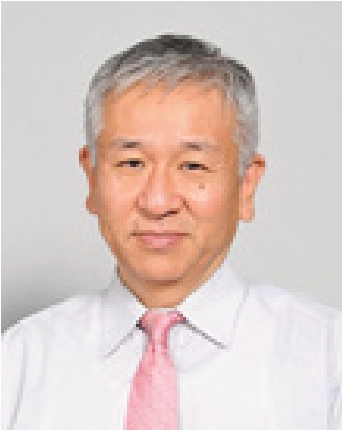
Received: 3 November 2021/Accepted: 5 May 2022/Published: 25 June 2022
Kenji IBA iba@ee.meisei-u.ac.jp
2096-5117/© 2022 Global Energy Interconnection Development and Cooperation Organization.Production and hosting by Elsevier B.V.on behalf of KeAi Communications Co.,Ltd.This is an open access article under the CC BY-NC-ND license (http://creativecommons.org/licenses/by-nc-nd/4.0/).
Biographies
Kenji IBA received the B.S and the M.S and Ph.D.degree in electrical engineering from Waseda University in 1978,in 1980 and in 1990,respectively.He joined Mitsubishi Electric Corp.in 1980.He has been a professor of Department of Electrical Engineering in Meisei University from 2004.Recently he is active on the field of Smart Grid,Battery Energy Storage System and Renewable Energy.He is a member or chairperson of some governmental committees of METI,NEDO,etc.Professor Iba is a fellow of IEEE and IEEJ.
(Editor Dawei Wang)
